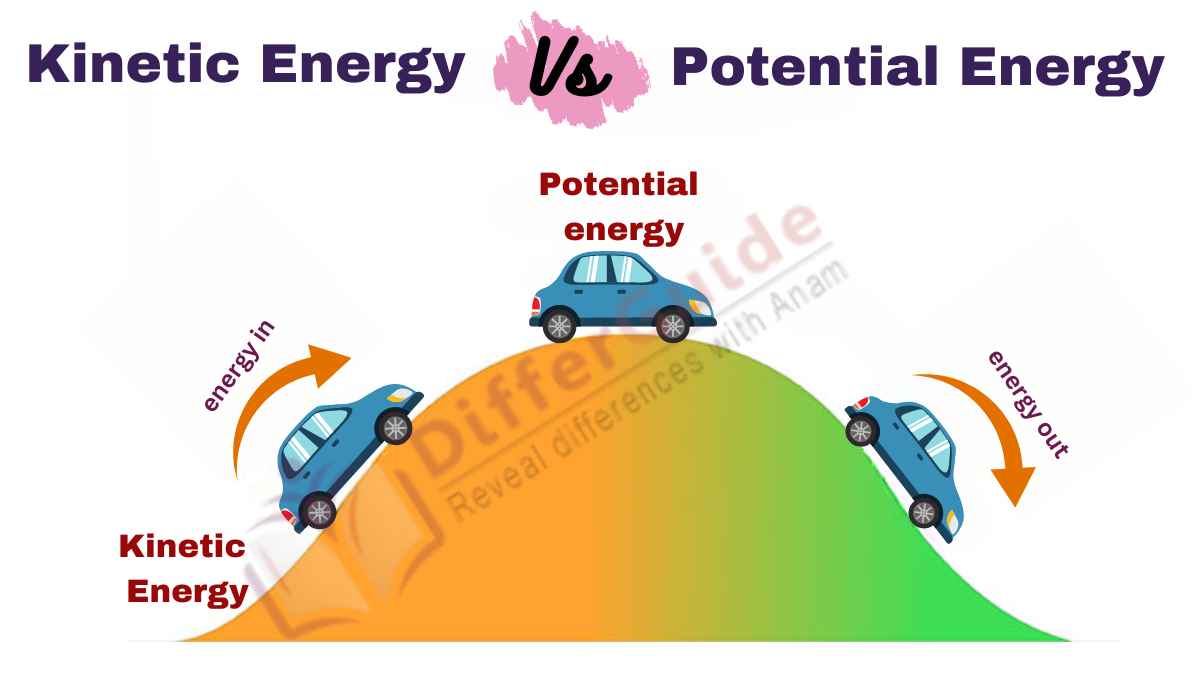The main difference between kinetic energy and potential energy is that kinetic energy is the energy of motion, while potential energy is the energy stored in an object’s position or condition.

In this article, we will discuss the difference between kinetic energy and potential energy. we will also give insight into both of them separately.
What is Kinetic Energy?
Kinetic energy is a fundamental concept in physics that describes the energy possessed by an object due to its motion. It is a scalar quantity and depends on both the mass of the object and its velocity.
The formula for kinetic energy is:
KE = 0.5 * m * v^2
where m represents the mass of the object and v is its velocity.
When an object is in motion, it has the potential to do work and cause changes in its environment. This energy arises from the object’s velocity, as a faster-moving object will have greater kinetic energy. For example, a moving car possesses kinetic energy that can be converted into other forms of energy, such as heat through friction or useful work through collisions.
Kinetic energy is proportional to the square of the velocity, which means that doubling the velocity will result in four times the kinetic energy. This relationship highlights the significance of speed in determining an object’s kinetic energy content.
In everyday life, the concept of kinetic energy is essential for understanding various phenomena, such as the impact of moving objects, the efficiency of machines, and the behavior of particles at the atomic and molecular levels. It’s a crucial factor in many scientific and engineering applications, contributing to the analysis and design of numerous systems.
What is Potential Energy?
Potential energy is a form of energy that an object possesses due to its position, condition, or composition. It is the energy that is stored within an object and has the potential to do work in the future. The concept of potential energy arises from the interactions between objects and their surroundings.
Formula
PE = m * g * h (mass, gravity, height)
Types of potential energy
Gravitational Potential Energy
This arises due to the position of an object within a gravitational field. The higher an object is positioned, the greater its potential energy, as it has the potential to fall and convert that potential energy into kinetic energy.
Elastic Potential Energy
Objects that can be stretched or compressed, like springs or rubber bands, store elastic potential energy when they are deformed from their equilibrium positions. This energy is released when the object returns to its original shape.
Chemical Potential Energy
This type of potential energy is stored within the bonds of atoms and molecules. When chemical reactions occur, this energy can be released or absorbed.
Nuclear Potential Energy
Particles within atomic nuclei experience forces that lead to nuclear potential energy. This energy is released in nuclear reactions, such as those occurring in nuclear power plants or atomic bombs.
Electric Potential Energy
Charged objects in an electric field possess electric potential energy. This energy is released when charges move within the electric field.
Kinetic Energy vs Potential Energy
The main difference between kinetic energy and potential energy is given below:
| Aspect | Kinetic Energy | Potential Energy |
| Definition | It is energy of motion. | It is the energy of position or state. |
| Formula | KE = 0.5 * m * v^2 (mass and velocity). | PE = m * g * h (mass, gravity, height.) |
| Unit | Joules (J). | Joules (J). |
| Source | Moving objects. | Position or configuration of objects. |
| Example | Moving car, running person. | Stretched spring, elevated object. |
| Dependence on Mass | Directly proportional. | Directly proportional. |
| Dependence on Velocity | Quadratically proportional. | Not dependent on velocity. |
| Dependence on Height | Not dependent on height. | Directly proportional to height. |
| Conservation Principle | Conservation of mechanical energy. | Conservation of mechanical energy. |
| Conversion | Can be converted to other forms of energy. | Can be converted to other forms of energy. |
